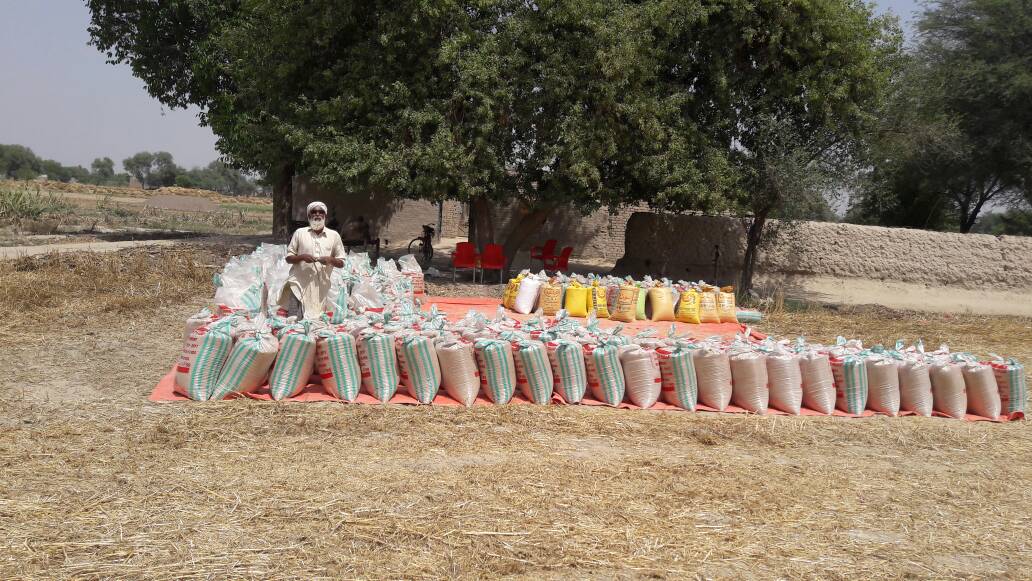
Zinc deficiency affects around 17% of the world’s population, mostly in developing countries. In Pakistan, the most recent national nutrition survey indicated that over 40% of women are zinc deficient. Could using a new type of flour in cooking help tackle this deficiency?
Popping a few multi-vitamin and mineral pills is routine to many people, and you probably know someone who is anaemic. In fact, according to Health Food Manufacturers Association, the UK public spent £414 million on vitamin and mineral supplements in 2015.
But millions around the world still remain malnourished through lack of adequate micronutrients in their diet. Micronutrient deficiencies are also known as ‘hidden hunger’ – a form of malnourishment that often goes unnoticed. The UN’s Sustainable Development Goals aim to end all forms of hunger and malnutrition by 2030, and this includes the eradication of micronutrient deficiencies.
Zinc deficiency affects around 17% of the world’s population, mostly in developing countries. In Pakistan, the most recent national nutrition survey indicated that over 40% of women are zinc deficient. Stunted growth and development in children, increased susceptibility to infections, and complications during pregnancy and childbirth are just some of the consequences of zinc deficiency. Potentially leading to severe illness and death, this seemingly invisible deficiency has a negative economic impact on the family, the community, and the region more broadly.
So in May 2017 we began investigating whether a newly developed strain of biofortified wheat could increase dietary zinc intake in Pakistan by integrating the wheat into normal eating habits.

It’s important to note that this isn’t the same as GM. GM crops are produced by transferring specific genes from other plants or organisms. Biofortified crops are developed using conventional plant breeding techniques, like cross-breeding standard varieties with their wild relatives over several generations. This means that biofortified crops are often more resilient to pests, diseases, higher temperatures and drought, as well as having higher micronutrient concentrations.
The biofortified zinc wheat in our trial is called Zincol/NARC421. It was developed by HarvestPlus, and approved for cultivation and distribution in Pakistan in 2016, so it is still relatively new. We are conducting a double blind, randomised controlled trial to examine the impact of consuming flour made from biofortified wheat on the zinc status of zinc deficient women. The biofortified flour is used to make chapattis – a staple food in the brick kiln communities of Peshawar.
We are also conducting field experiments to determine the value of adding zinc enriched fertilisers to wheat production in Pakistan, both in terms of yield and potential health benefits. It is important to demonstrate the cost-effectiveness of genetic and agronomic biofortification, to encourage farmers to invest in new seeds and zinc fertilisers, and persuade governments to invest in scaling-up biofortified zinc wheat.
One of the key challenges in measuring zinc status is the lack of a sensitive biomarker that is suitable for use in remote settings. So we are using this study to compare established biomarkers of zinc status (plasma zinc concentration) with novel indicators, including markers of DNA damage and a new laser technique for measuring nail and hair zinc concentration.

Our team will be visiting Pakistan in March 2018 to meet with our research partners. For some of us, this will be the first face-to-face meeting after months of working together. We are also planning an external showcase event, which will be attended by a range of stakeholders including representatives from international NGOs and the UK and Pakistan governments, to showcase the importance of tackling micronutrient deficiencies in context of the broader food security challenge.
The success of a biofortification strategy requires that the intervention achieves wide and sustained uptake at production and consumption stages. The next phase the project will therefore explore the cultural context, traditions, knowledge and attitudes of local stakeholders to biofortified zinc wheat and zinc fertilisers.
Ultimately, we hope that our research will help to establish biofortified zinc wheat as a sustainable and cost-effective solution to zinc deficiency in Pakistan and around the world.
About Heather Ohly
Dr Heather Ohly is a Postdoctoral Research Assistant at the University of Central Lancashire, with a research background in maternal and child nutrition. Heather enjoys working on international and interdisciplinary projects like this one, which involves experts in nutrition, global health, agriculture and plant science.
About the project
BiZiFED: Biofortified Zinc Flour to Eliminate Deficiency is funded by the BBSRC Global Challenges Research Fund.
BiZiFED is in collaboration with:
- University of Central Lancashire (Grant holder/lead institution)
- Abaseen Foundation
- Fauji Fertilizer Company
- Khyber Medical University
- London School of Hygiene and Tropical Medicine
- University of Nottingham
Follow the project on Twitter @UCLanHealth.




do you have Present graphical status of zinc as compared with that reported in previous surveys